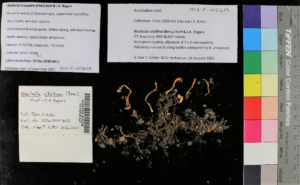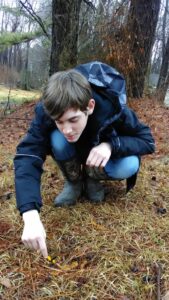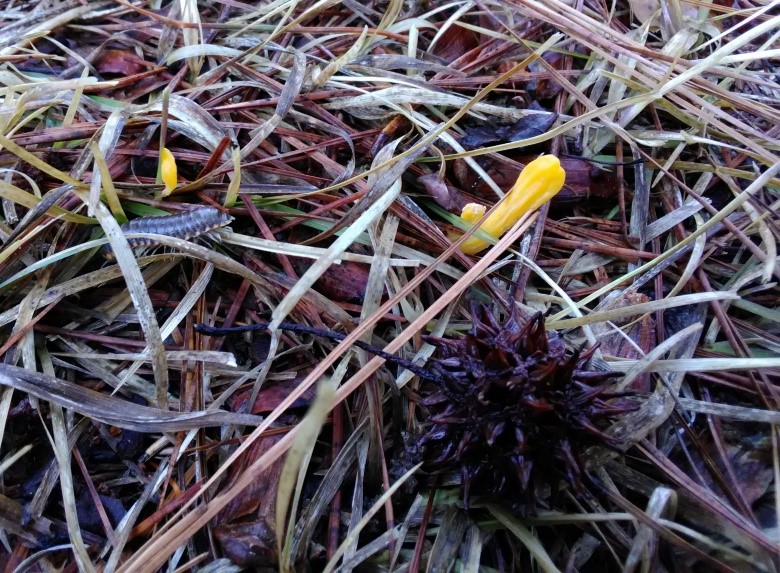by Van Cotter, Herbarium Research Associate, UNC at CH Herbarium (NCU) and John S. Gibbs, Willow Spring, North Carolina
Thanks to the dedicated mycological exploration by the junior author, who is 13 years old and has an avid interest in mycology, the University of North Carolina at Chapel Hill Herbarium (NCU) now has the first vouched collection of Neolecta vitellina recorded from North Carolina.

Neolecta, an Ascomycete fungus, is of great scientific interest as it is highly unusual and has no close relatives – so unusual it has its own class, Neolectomycetes, in which there are no other genera. Some have called Neolecta a living fossil or a dinosaur fungus. The closest relatives it does have look nothing like it and have yeast-like forms, including both plant and human pathogens. In fact, the fungi that look most like Neolecta, the yellow coral fungi, being Basidiomycetes, are as far removed phylogenetically from it as the common grocery store button mushroom is.
Another oddity of Neolecta is its ecological role is uncertain. No one has successfully grown it in culture, suggesting that it is not a decomposer, as decomposer fungi can generally be grown in culture. This leads to the hypothesis that Neolecta is obligated associated with trees either as a root pathogen or a mutualistic partner, and indeed there is some evidence that it may be a pathogen.

John was able to nail the identification of this curious fungus to the genus Neolecta based purely on macroscopic and chemical features, not a minor feat! Given that those North American mushroom field guides that include Neolecta only cover N. irregularis, rarely with a passing notice that there is a second Neolecta species in North America, John reasonably concluded his find was Neolecta irregularis. Then using the scientific literature, Van concluded it was the other species, N. vitellina. Thanks to the generosity of Dr. Rytas Vilgalys of the Duke Mycology Lab, Van was able to extract and amplify the ITS DNA region (the “fungal barcode”) of two of John’s fruiting bodies and the ITS sequences confirmed the fungus was indeed N. vitellina.

Each week John (Fig. 3) documents the macrofungi fruiting on his family’s property in Willow Spring, an acre which mostly consists of mixed woods of loblolly pine, water oak, sweet gum, and red maple. The pine and oak trees mean there are numerous ectomycorrhizal mushrooms that fruit on the property, and with the litter, many saprophytic macrofungi of which he has to date found almost 100 different species. In total, he has documented nearly 200 different species of fungi, representing five ecological roles, on the acre so far. Regarding Neolecta vitellina, he is inspired to try propagating it on loblolly pine seedlings. Stay tuned!
Photo credits: Figure 1 – Van Cotter; Figure 2 photos – John Gibbs; Figure 3 – Jasmine Gibbs.
